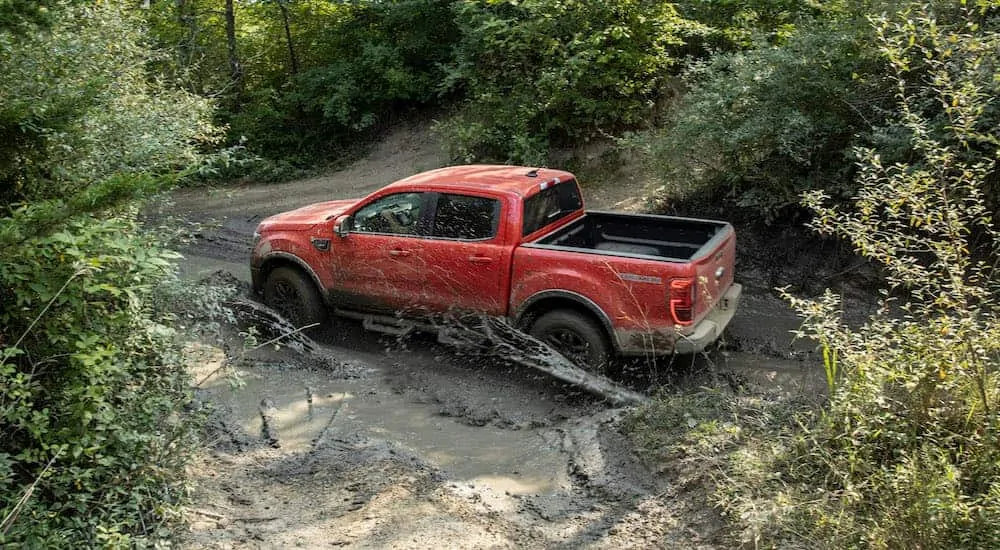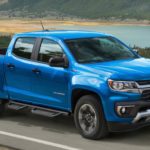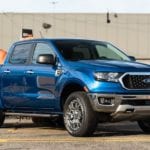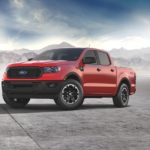You might want a full-size pickup, but you worry all that hulking heft will overtake your driveway and drain your wallet at the pump. What other options are there? Midsize trucks fell out of favor for a few years, but they’re making a solid comeback, and in 2019 Ford brought back the popular Ranger. Today’s 2021 Ford Ranger takes the concept of a full-size pickup and dials down the bulk just enough to eliminate the excess and focus on the goods.
The Ranger is the next-to-smallest truck in its class, meaning it doesn’t care to compete with its full-size brethren at all. Instead, it focuses on what it’s designed to do: provide all the utility of a bigger vehicle in a more compact and efficient package. You’ll still get respectable max towing and payload capacity, along with cab options that accommodate everything from the job site to a road trip with the family.
Starting at a fairly budget-friendly price, the 2021 Ford Ranger is an attractive option in a world of ever more expensive trucks. Even fuel economy demonstrates Ford’s commitment to affordability. The Ranger achieves an average rating of 21 MPG city and 26 MPG highway because of its efficient powertrain consisting of a 2.3-liter four-cylinder turbocharged engine and a 10-speed transmission.
Details matter. Budget matters. And yes, size matters. We like how the 2021 Ford Ranger fits into the mix because it focuses on not being too big or too little – it’s just right. The right price, size, and range of features are what help put the Ranger near the top of the list in its class, even when faced with more well-established vehicles, like the Toyota Tacoma.
But what about even smaller trucks? Does the success of the Ranger and other midsize models mean there is an opportunity to bring back the compact pickup truck? For a while, these tiny utility trucks were a relief for buyers that didn’t want to get stuck in a nondescript compact sedan. The category has been dormant for years, but with the rise in more non-traditional body styles, it’s obvious that buyers like to have options.
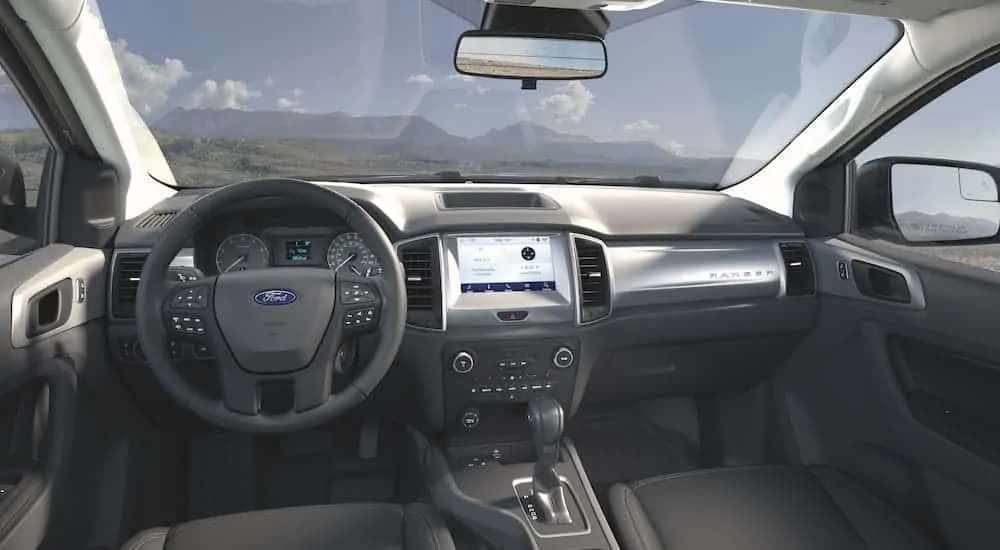
What Happened to Smaller Trucks?
Ford originally left the midsize and compact pickup truck markets in 2011, temporarily retiring the Ranger for around nine years. Lagging sales were the primary reason, but Ford also wanted to focus on its best-selling full-size pickup line. Also, the company’s research revealed that buyers chose the Ranger because of price, not because it was a pickup truck. With that data on hand, Ford focused on building budget-conscious vehicle options, like the now-discontinued Ford Fiesta.
The company has yet to re-enter the compact pickup market, which begs the question, what happened to demand for small trucks? Ford continues to cite declining demand as the primary reason – however, it might be time for them to reconsider because consumer behavior is telling a different story. Based on the success of quirky, affordable vehicles like the MINI Cooper and the Kia Soul, it appears that customers are embracing budget vehicles with alternative body styles. The days of building simple compact sedans and expecting them to satisfy every entry-level buyer are over.
One of the key behavior differences between compact pickup truck owners and larger pickup truck owners was compact pickup truck owners often customized their vehicles with aftermarket equipment. That’s significant because the lower price point of a compact pickup truck allowed for expensive enhancements. That freedom to design a custom rig fell by the wayside when the category essentially disappeared, which means those buyers ended up in other categories. But which categories? What if their motivation for choosing a compact pickup truck wasn’t the low price alone? What if it was primarily for the body style and Ford’s research is flawed?
The Future of the Pickup Truck Market
According to a 2011 article in Boston Magazine, reporter Craig Fitzgerald cites the growing popularity of budget SUVs, like the Kia Soul, as an indication that relaunching a compact pickup truck could likely be very successful. His observation implies that buyers in the lower price range look to product differentiation as a way to express their individuality. In other words, budget buyers don’t want to get stuck in an anonymous compact sedan.
Ed Hellwig of edmunds.com agrees. He states that the primary reason buyers chose compact pickups like the old Ford Ranger body style “wasn’t because they were small. It was because they were cheap.” This agrees with Ford’s research. However, he goes on to point out that if a buyer had to choose between a sedan and a pickup for essentially the same price, most buyers would choose the latter. While the decision was still based on price, given the option, these buyers are choosing a more exciting body style.
Research and history support the notion that buyers would accept a stripped-down, minimally capable pickup truck if it could be purchased for the same price as a compact sedan. That means Ford can leave out typical pickup truck capabilities, like good towing and payload capacity, and instead focus on design. Add a few enhancement packages for those that want a truck of that size but have the money to add some convenience and comfort options, and suddenly the category is reborn.
Compact pickup trucks appealed mostly to younger men on a budget, and it’s likely that segment of buyers is distributed across many different vehicle segments. Winning a younger male demographic back into the Ford family gets an entirely new group of buyers in a position of becoming brand loyal over the long term, which means graduating them into larger, more expensive vehicles. Perhaps the compact pickup truck category could be something of a loss leader.
Going forward, it makes sense for automakers to dive into the deeper meaning behind why certain body styles were popular at various times in history. Purchasing a car is an emotional experience because, for Americans in particular, our cars are a reflection of our personalities. We want to drive a vehicle that makes us feel proud and that we enjoy climbing into every day. If a buyer is limited by price, their options will be limited, and they’ll need to narrow their choices and likely compromise. Still, as the automotive industry recognizes the importance of the economy buyer to their overall business, it seems a marriage of convenience is in order.
Ford should explore relaunching a version of its very popular compact pickup truck. We think it’s possible to find the sweet spot between price and features because, paradoxically, the compact pickup truck buyer isn’t really looking for a pickup truck. This means that expensive components like big engines, four-wheel drive drivetrains, and exceptional towing capacity aren’t necessary. Instead, Ford should build a cheap compact pickup as an alternative to the default – and less exciting – compact sedan or crossover that these buyers don’t feel are a fit. Fortunately, there is a hint that Ford just might be taking our advice with the rumored Ford Maverick compact pickup.
In America, we want to love what we drive. Budget should not stand in the way of buyers being able to achieve that goal. The definition of a pickup truck doesn’t always have to be rugged off-roading and towing capability: it can simply be an alternative body style at certain price points. We hope to see all automakers continue building non-traditional cars, trucks, and SUVs to keep buyers interested and excited.
